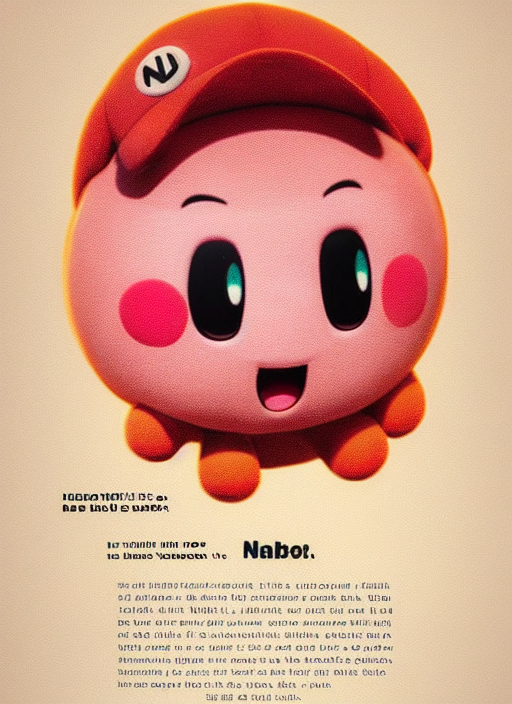
A “very normal uncursed kirby,” generated by 0xabad1dea. Twitter post.
A “somewhat more cursed kirby,” from the same post:

The Flipside of Gaming

A “very normal uncursed kirby,” generated by 0xabad1dea. Twitter post.
A “somewhat more cursed kirby,” from the same post:

It’s hard to believe that Legend of Zelda fangame construction system Zelda Classic and ZQuest is 23 years old. Many such systems have fallen by the wayside during that time, but Zelda Classic continues on. Its first versions were made for DOS, but it continues to see improvements to this day.
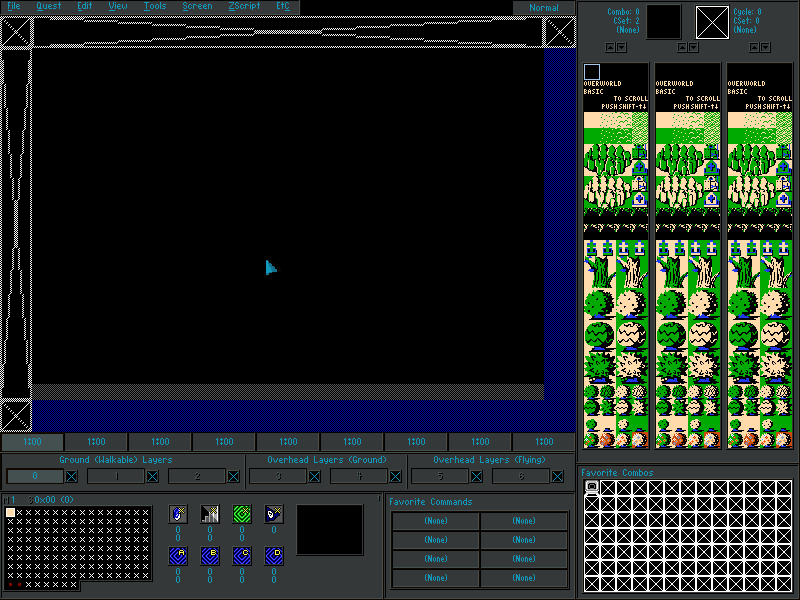
Zelda Classic and ZQuest are made specifically to make overhead view action-adventures in the Legend of Zelda style, to the extent that it has graphic sets taken directly from the games and many items that work like their console counterparts.
It even simulates many of the quirks from the various Zelda series titles. And yet, it doesn’t require you to abide by them. Pretty much every technical or creative limitation of the 2D Zelda series has an option to disable it if you like, but if for some reason you consider it intrinsic to the experience you can keep it too.
The graphics can be completely changed out. With it, you can make a game that doesn’t look anything like a Zelda title, which I suspect is why it’s been able to survive 23 years in a legal landscape overseen by a Nintendo increasingly draconian in its approach to guarding its intellectual property. Still, it’s pretty heavily aimed at making Zelda fangames, right down to having pages and pages of checkboxes for every known quirk of Zelda engine behavior.
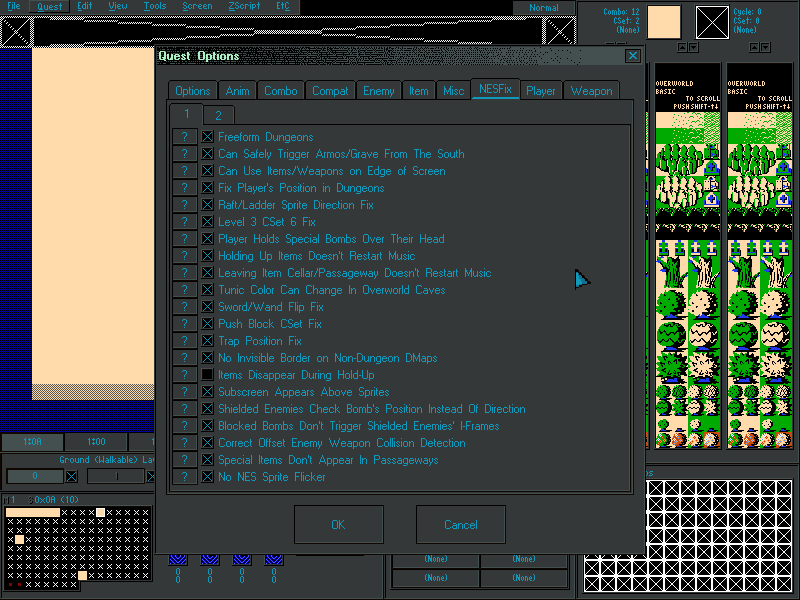
While it does offer a scripting facility (which it’s difficult to find documentation for), ZQuest is mostly a construction set type of program. You place tiles and enemies, lay out overworlds and dungeons, decide what items to include, and go. The program itself has little in the way of documentation but the site has a tutorial that should help one get started. I strongly suggest, if you are interested in creating for this system, that you read it.
Fan projects going on for this long suggests a kind of mania, but the ZQuest people are serious. They even forked Allegro to fix bugs and adapt it for their purposes. May they keep it going for another 23 years and beyond.

“We scour the Earth web for indie, retro, and niche gaming news so you don’t have to, drebnar!” – your faithful reporter
At NintendoLife, Alana Hauges notes a dispute between Corecell, developers of AeternoBlade II, and publisher PQube. It’s all a bit tl;dr, and that isn’t helped by the decision to put PQube’s lengthy response up front, undercutting Corecell’s arguments before we can even read them. In summary, Corecell claims PQube didn’t pay them for milestones, and PQube claims Corecell was unresponsive to their requests for fixes and offered to return rights. I mean, it’s rather they-said/those-others-said, but I note that PQube’s bring up the game’s poor sales, an irrelevant issue at best, is bad form. But we’re all busy blobbies and hey, here’s the next article.

Even more depressing news, PC Gamer’s Ted Litchfield tells us that Girls Who Code, a non-profit dedicated to helping women get careers in the tech industry (good) was participating in a mentorship program set up by US arms manufacturer Raytheon Technologies (awful).
In more entertaining news, Vikki Blake at GameRadar mentions that Halo Infinite players have managed to discover a way to force a split-screen multiplayer for that game.
Isaiah Colbert writing for Kotaku informs us that Nintendo’s ending the gacha elements in their mobile game Mario Kart Tour. I’m glad to see this scourge of gaming slowly wane. Instead, players will purchase unlockables directly instead of hoping for lucky draws.

Bryan at NintendoEverything has an interview with Chris Kohler of Digital Eclipse and Konami producer Charles Murakami about DE’s collection of 13 classic Teenage Mutant Ninja Turtles games. Digital Eclipse consistently does such good work these days and it’s a good recounting of the highs of the package and the work involved in bringing it to us.


Nicole Express regularly has great long-form posts, and this one goes into some detail about Famicom and NES mappers and how they were used to extend the capabilities of the system.
Nicole Express: What made the NES so interesting?
Games Featured:

Owner of Game Wisdom with more than a decade of experience writing and talking about game design and the industry. I’m also the author of the “Game Design Deep Dive” series and “20 Essential Games to Study”
A lot of the gaming web has been fawning over Kirby and Smash Bros. creator Masahiro Sakurai’s design videos. I haven’t had the chance to look at them yet, but they look interesting at least. They’ve been coming out at a good clip, like one every two days.
Sakurai’s star is so high right now, that it’s worth noting that (going by memory) he left Nintendo with a bit of a cloud over his head, after Kirby Air Ride was seen as something of a failure. Nowadays KAR (nice acronym!) is seen as an underrated classic, and I have put many hours into its City Trial mode, which is terrific, a tiny open-world high-speed racing/party game. More people should have the chance to play it; it is unique, which is something I can’t say about many other games. While the 3DS version of Smash Bros. has a mode inspired by it, in versus mode human players cannot interact with each other during the exploratory portion of the game, which harms it somewhat.
At the height of his abilities, Sakurai can make really interesting and new kinds of games, like Smash Bros. was, and like Kirby Air Ride and (the sadly neglected these days) Meteos are. It’s a shame that Smash is so popular, one of Nintendo’s biggest tentpoles, enough to crowd out his other work. I’m really interested to see what the next crazy idea he comes up with will be!
Sakurai’s Game Design Videos, on YouTube

Owner of Game Wisdom with more than a decade of experience writing and talking about game design and the industry. I’m also the author of the “Game Design Deep Dive” series and “20 Essential Games to Study”
Long, long ago, three full ages before Zuckerberg’s doomed Metaverse, there was Lucasarts, formerly Lucasfilm Games, and Maniac Mansion, and the SCUMM engine.
Lucasarts went on to have a long legacy of adventure games, and while it’s gone now and most of its progeny is owned by some mouse creature, it survives in a number of forms, like the upcoming Monkey Island re-revival.
Another legacy of Lucasarts and SCUMM is what is possibly the first graphical MUD, called Habitat.
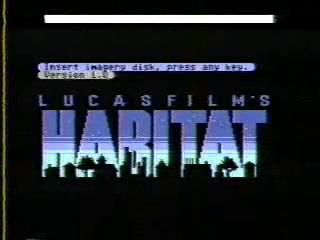
What? You don’t know what a MUD is, or a MOO or a MUCK? A lot of knowledge is in danger of being lost, but we don’t have time to remind you of rudiments here.
Habitat was an early experiment in online communities, a server-based virtual world whose clients were Commodore 64s. In appearance it looks a whole lot like a multiplayer version of Maniac Mansion.
It never went public, but did eventually become a paid feature, in modified form. on the C64 online service QuantumLink under the name Club Caribe. Then, with the wane of the Commodore 64 as a viable platform, QuantumLink closed their servers and rebranded as America On-Line, a.k.a. AOL. And that is not only history at this point, but ancient history. Read more about it here.
While there was still competition in the dial-up online service space, two creators of Habitat, Randy Farmer and Chip Morningstar, partnered with Fujitsu to have another go at a Habitat-style service, this time called WorldsAway. They partnered with AOL competitor CompuServe, and didn’t do badly for a while.
There’s all kinds of things to talk about here, and I have rather more knowledge than most because I was involved with this, I was volunteer staff at the flagship WorldsAway world, called Dreamscape. I was a participant in the CompuServe forum before the main service even opened, I spend an entire night on the phone as a teen, our old 486DX running Windows 3.11 downloading the client software.
WorldsAway was basically my life for a few years. It could be incredibly addicting, and spirits were high in the early days. There was a feeling of being at the forefront of something. The Internet was just starting to become really big. Who knew what it would become?
What happened to WorldsAway is a story, one that I’m probably not qualified to tell. I know there were problems with business management even from the start. The world staff was constantly said to be fighting with higher-ups, who wanted to cheapen or diminish the project. In size, certainly, the initial world Dreamscape never got anywhere as large as what we hoped for. Even compared to the size of its Commodore 64 predecessor Club Caribe, it was pretty small.
It’s said that they were a west coast operation, and many of their staffers were queer. One of the eventual spinoff worlds that WorldsAway would spawn was explicitly queer-friendly. Given the successes and continued struggles of queer-friendly media on the internet today, I feel like WA’s acceptance of alternate lifestyles should probably be better known.
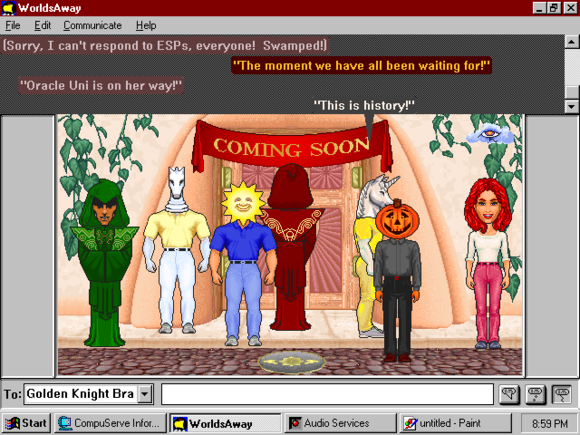
I still have a couple of friends from those days. Others I’ve sadly lost touch with. A few friends from that time, notably Tiggles, Esme, and Rosaleah, have departed our physical world as well. Maybe some comfort could be had in the idea that maybe they’re users in some higher-order reality, who may have logged-off of our world, but are still out there in a more profound form. If they’re out there and somehow seeing this: please spare a thought for me. I’ll be back out there some day.
The Reno Project is a website devoted to preserving as much of those early projects, those ancient times, as possible. You could immerse yourself in the screenshots there, and dream of a past era that barely was. One of its competitors at the time, which is a bit better known today, is The Palace. One other service that still exists that competed with it is There, although good luck making an account (I tried). And Second Life of course continues to chug along. All of these things seem to me like more worthy projects than Zuckerberg’s latest progeny.
For each night of Gamescom, I streamed my entire plays of demos and these video parts are the collections of them.

Owner of Game Wisdom with more than a decade of experience writing and talking about game design and the industry. I’m also the author of the “Game Design Deep Dive” series and “20 Essential Games to Study”
VGDensetsu hasn’t appeared in these pages yet and it’s high time we remedied that. This particular link is to a five-part series about an animator who switched careers to doing illustration for Nintendo, and played a major role in determining the look of many of their most popular characters, including Mario and Link.

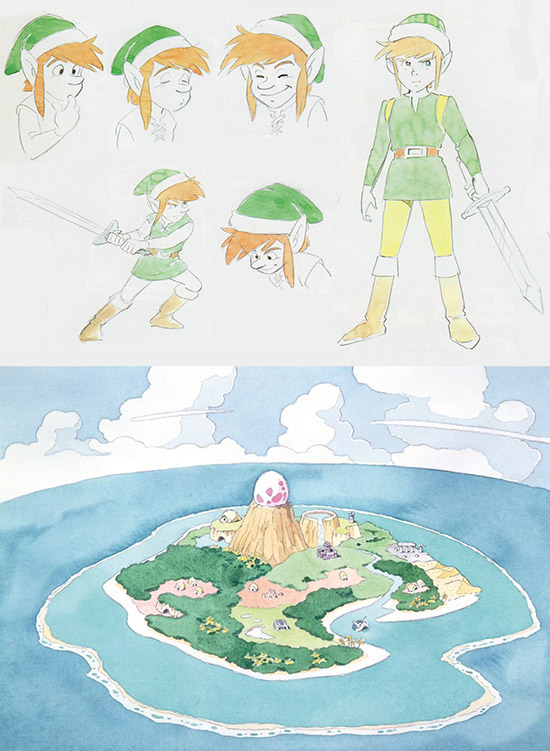
VGDesetsu: Yōichi Kotabe — 60 Years of Animation and Video Games
1. The Toei Era – 2. From One Studio to Another – 3. From Animation to Nintendo – 4. Diversification and Transmission – 5. Towards New Horizons
Its Sunday! Another week in the books! You made it. So, here’s a weird video something you may enjoy.
On the original Playstation there were a lot of games release, some good, some bad, and some rather strange. Since games were released on CD, there was a lot of space for full-motion video, and sometimes that allowed developers to build in some silly extras.
That’s what happened with the Golden Nugget game, a fairly standard gambling sim that was elevated to sublime levels of wackiness by its video clips. It’s a fairly standard shoehorned-in story, about a computer chip that allows one to win games of chance somehow, but then Adam West shows up, as “Mr Swayne,” starts Adam West-ing, and suddenly, you’re watching comedy gold.
There’s a lot of other-character-acting to wade through to get to Adam, so you’ll want to skip forward to 8:10 to see his first bit.
A spotlight on some interesting posts from August….
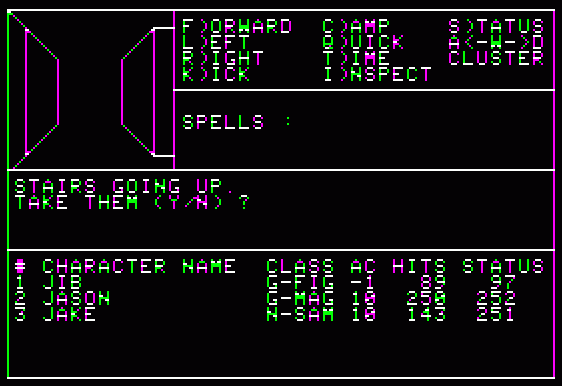
2nd: What are blobbers? Wizardry-style maze games, usually party-based dungeon crawls. How many has there been? At least 48, and definitely a lot more!
8th: A short post, but interesting. I found, from the official Nintendo SNES devguide on the Internet Archive, a list of things that could get a game rejected.
10th: It was all over the internet, but still, we reported on that hidden cheat code in Super Punch-Out!! that let you play it against a friend.
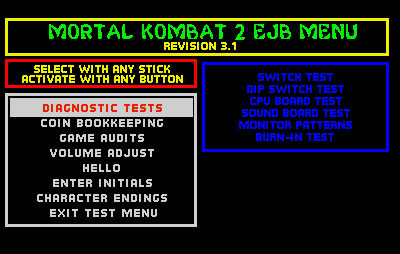
11th: The developer menu buried in arcade versions of Mortal Kombat and its sequels and how to access it from attract mode. Since then, I’ve had the opportunity to show this off to multiple people in Ultimate Mortal Kombat 3 and it never fails to impress.
12th: Mamesaver, the screensaver that uses the roms in your MAME folder.
13th: Revivals of old online services QuantumLink, AOL, and Prodigy. No word about Compuserve though.
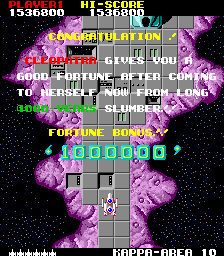
15th: Arcade Mermaid visits Vs. Castlevania, in which a hard game gets much, much harder.
16th: Hyrule Interviews, a ton of information that the developers of Zelda games have revealed to the media.
17th: An old video but still fascinating, the last new Data East Jurassic Park pinball machine is opened on camera.
19th: Chasing the world record in Hatetris, a player-hostile Tetris variant.
22nd: NCommander on Youtube on why 3D Pinball was removed from Windows Vista.
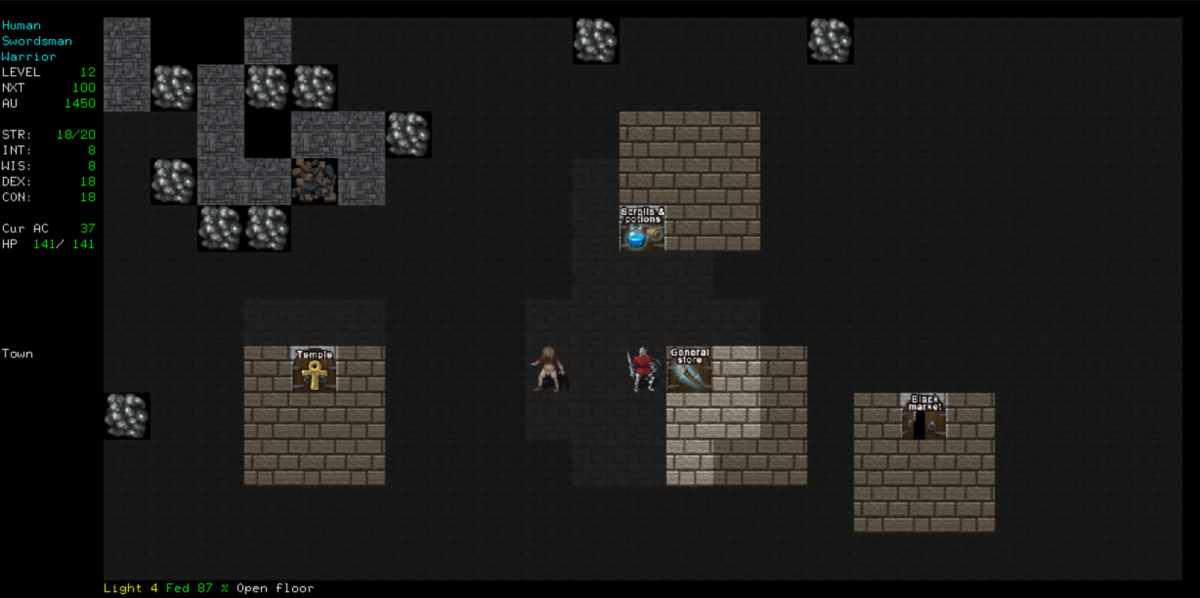
27: The absurdly weird and detailed romhack of the prototype of Monster Party, starring Elvira!
29th: The long (in both number of entries and runtime) Youtube series Identifying Luck in Mario Party, which is an amazing detailed look into the internals of those games.
30th: The Museum Monster presents a weird moment in video games: the Cleopatra bonus in arcade Star Force.
@Play: Reintroduction to Angband – Playing the game
Sundry Sunday:
Lore Sjoberg’s Alt Text: The Five Most Guilt-Inducing Video Games
Old Commercial for Pitfall!, with a young Jack Black
Strong Bad Email #94, Video Games
Cabel Sasser’s Buggy Saints Row: The Musical
Josh Bycer’s indie dev posts:
Store Page Review of Metroplex Zero
Interview with Dave Gilbert of Wadjet Eye Games
Interview with independent dev Brian Cronin
Interview with Gideon Griebenow of World Turtles
Store Page Review of Transcendence
Indie Game Showcase:
8/6: Mahokenshi, Gastova The Witches of Arkana, Castle Cardians, Transiruby, Vesper Ether Saga, BackBeat
8/12: Ancient Gods, Critadel, Deiland: Pocket Planet, Monster Tribe, Zoeti, Printersim
8/15: Spellbook Demonslayers, Mech Shuffle, Endling Extinction is Forever. Ginger the Toothfairy, Lightsmith, Myth of Mirka, Supernova Tactics, Fabled Lands, Kokoro Clover Season 1
8/22: Trinity Archetype, Green With Energy, Super Grave Snatchers, The Lightbringer, Happenlance, Timemelters
8/24: Affogato, Rogue Genesia, City Limits, The God Unit, Redshot, Combo Card Clashers
8/27: Evertried, Sands of Aura, The Shore, Infraspace, Rogue Spirit, Ruin Raiders
8/29: Hex of the Lich, So to Speak, It’s a Wrap, We Took That Trip, Eternal Remnant The First Chapter, The Mortuary Assistant
To find more interesting posts, please look through our over-full sidebar. We now have archives that you can browse from! Many posts you find here aren’t the sort to go obsolete, so as we put up more and more content, you’ll find more and more wonderful stuff to discover there.
Thanks for reading Set Side B through the month of August! We will continue bringing you the most interesting finds from the Flipside of Gaming.